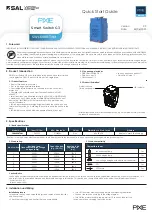
5-35
Cisco Content Services Switch Getting Started Guide
OL-6037-01
Chapter 5 Where to Go Next
Comprehensive CSS Documentation List
Chapter 5, Source
Groups for Services
•
Overview of source groups and port mapping
•
A source group configuration quick start
•
Configuring a VIP address, service, and destination service
•
Activating and suspending a source group
•
Configuring port mapping including a starting port, number of ports in
a port-map range, and a VIP address range, and disabling port mapping
•
Configuring source groups with ACLs, for FTP connections, and to
allow servers to resolve domain names using the Internet
•
Displaying source group information and clearing counters
Chapter 6, Configuring
Loads for Services
•
Overview of service loads
•
A relative load configuration quick start
•
Configuring relative loads including global load reporting, load step,
load threshold, and teardown and ageout timers.
•
Displaying global service loads
•
An absolute load configuration quick start
•
Configuring the absolute load calculation method including modifying
and optimizing the absolute load scale, and setting the load variance
•
Displaying relative load statistics and absolute load calculation ranges
•
Using ArrowPoint Content Awareness (ACA) load-balancing algorithm
to balance traffic between a group of servers based on load and weight
Chapter 7, Configuring
Dynamic Feedback
Protocol for Server
Load Balancing
•
Overview of Dynamic Feedback Protocol (DFP)
•
Configuring a DFP agent to listen for DFP connections on a particular
IP address and TCP port combination on a server, and to enable the DFP
manager on the CSS
•
Maintaining a consistent weight range among services
•
Displaying DFP information, including configured DFP agents and
supported services
Table 5-4
Cisco Content Services Switch Content Load-Balancing Configuration Guide (continued)
Chapter
Contents/Tasks
















































